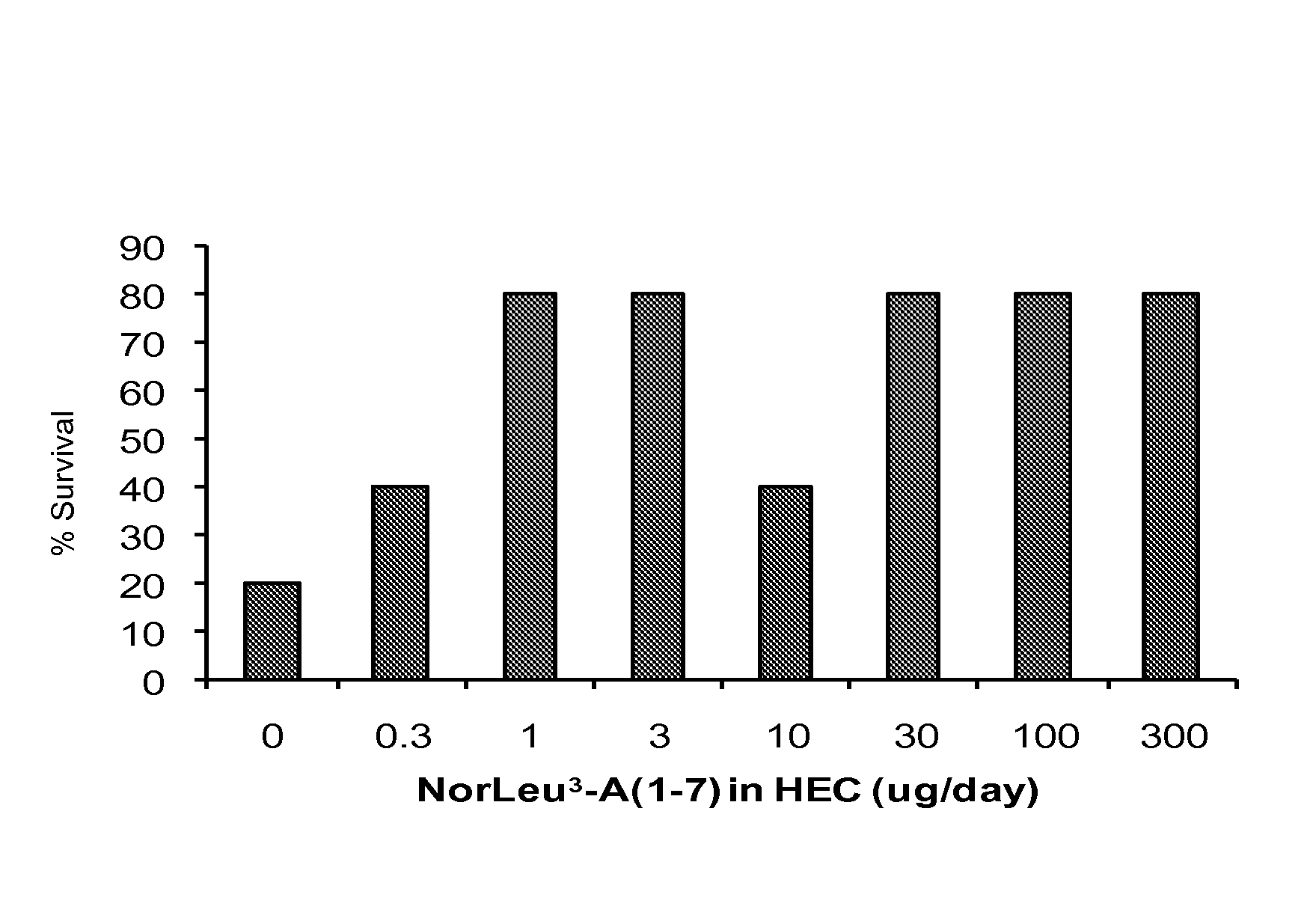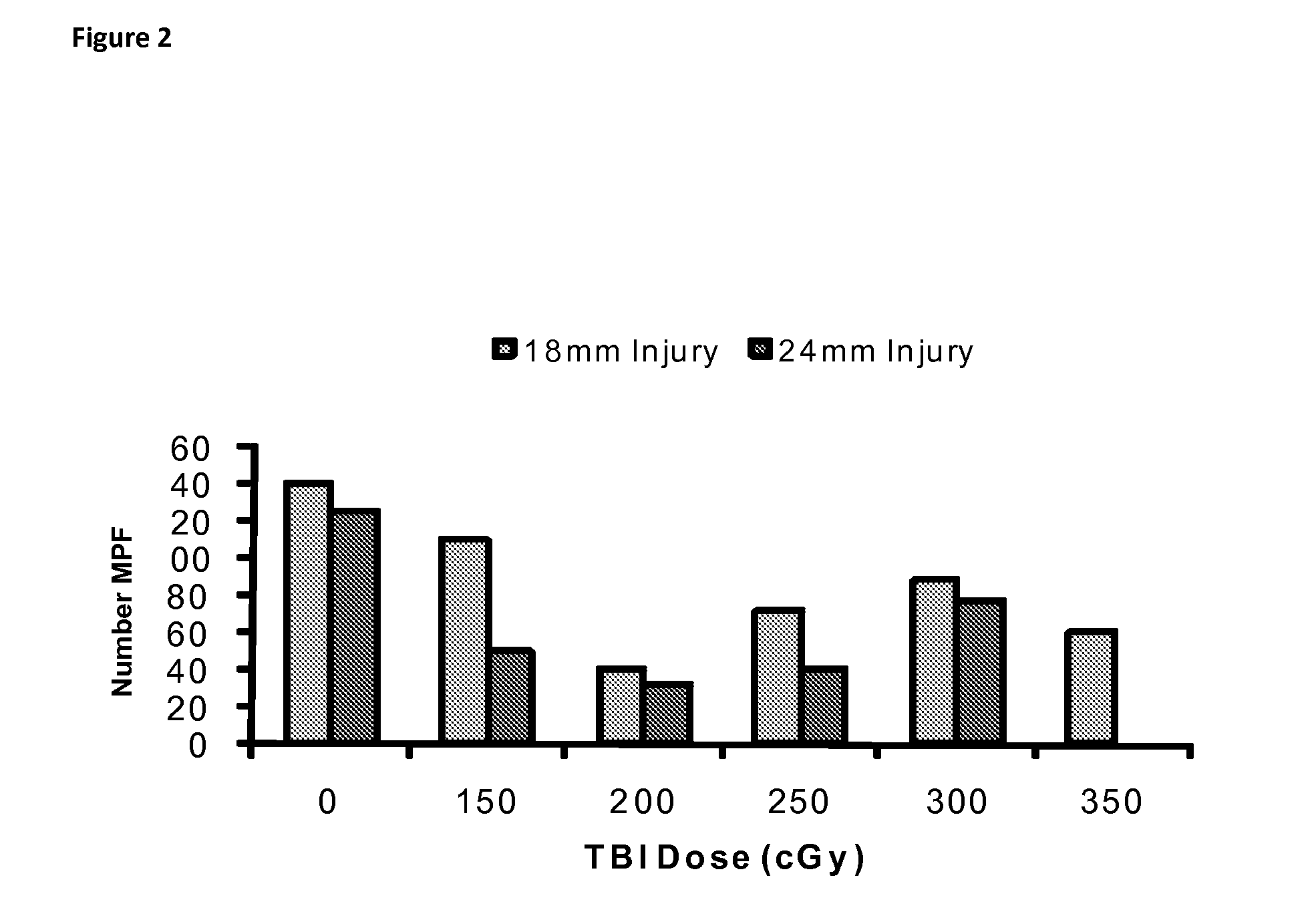Methods for treating combined radiation and thermal injury
a combined radiation and thermal injury technology, applied in the direction of drug compositions, antinoxious agents, peptide/protein ingredients, etc., can solve the problems that individuals exposed to high levels of ionizing radiation will likely suffer not only radiation sickness but also thermal-induced injuries, so as to accelerate burn healing and improve survival in the subj
- Summary
- Abstract
- Description
- Claims
- Application Information
AI Technical Summary
Benefits of technology
Problems solved by technology
Method used
Image
Examples
example 1
Guinea Pig Model for Combined Radiation / Body Injury (CRBI)
[0035]A model for combined injury was developed in guinea pigs. The model development involved evaluation of five levels of total body irradiation (TBI) combined with 2 sizes of thermal injuries to determine the optimal combination to delay healing with minimal mortality. There was unacceptable mortality, particularly with the larger burn size at the two highest dose of TBI. The ability of TBI to delay healing was measured by the number of cyclin positive cells in the basal epidermis and hair follicle bulge. The proliferation data of day 14 animals are presented (FIGS. 1 and 2). At a TBI dose of 200 cGy and greater, there was a consistent reduction in the number of proliferating cells in the bulge region of the hair follicle and at the basal keratinocyte layer both at the burn site and at the edge of the burn. As these two cell populations are responsible for re-epithelialization of the thermal injury, 200 cGy combined with t...
example 2
Efficacy of NorLeu3-A(1-7) in CRBI Models
[0036]In a subsequent study, 200 cGy TBI was combined with 18 mm burn injuries in a NorLeu3-A(1-7) dose-response study. On the day of thermal injury and daily through day 14, various concentrations of NorLeu3-A(1-7) (0-300 μg / day) were applied to the site of thermal injury (FIG. 3). Application of 1 μg / wound / day NorLeu3-A(1-7) and above reduced mortality associated with combined injury in guinea pigs. At doses of 10 μg / daily NorLeu3-A(1-7) and above, there was an increase in the number of cells in the basal keratinocyte layer at the edge of the burn (FIG. 4). At all doses (except 3 μg / wound / day), NorLeu3-A(1-7) increased the number of proliferating cells in the hair follicle bulge at the edge of the wound (FIG. 5).
example 3
Determination of Time Point NorLeu3-A(1-7) Can be Initiated in Guinea Pigs
[0037]A second study was conducted in this model to assess the length of time that treatment can be delayed and still reduce mortality. In this study, the guinea pigs underwent 200 cGy TBI and thermal injury 2 hours later. Treatment with placebo was started on day 0. Treatment with 10 or 100 μg / daily NorLeu3-A(1-7) was initiated on day 0, 1, 2, 3 or 4. When treatment was started at days 0, 1, 2, or 3 survival was increased to approximately 40-60% versus 14% in the placebo-treated animals (FIG. 6-9). However, if the initiation of treatment was delayed until day 4, effectiveness was reduced.
Methods
[0038]For these studies, male Hartley guinea pigs weighing approximately 500 grams were purchased from Charles Rivers Laboratory (Charles Rivers, Mass.). The guinea pigs were housed in a 12:12 hour, light:dark, cycle in the USC Vivaria. The animals received 200 cGy TBI using a Cesuim 137 irradiator. One to two hours th...
PUM
| Property | Measurement | Unit |
|---|---|---|
| diameter | aaaaa | aaaaa |
| concentration | aaaaa | aaaaa |
| surface area | aaaaa | aaaaa |
Abstract
Description
Claims
Application Information
 Login to View More
Login to View More - R&D
- Intellectual Property
- Life Sciences
- Materials
- Tech Scout
- Unparalleled Data Quality
- Higher Quality Content
- 60% Fewer Hallucinations
Browse by: Latest US Patents, China's latest patents, Technical Efficacy Thesaurus, Application Domain, Technology Topic, Popular Technical Reports.
© 2025 PatSnap. All rights reserved.Legal|Privacy policy|Modern Slavery Act Transparency Statement|Sitemap|About US| Contact US: help@patsnap.com



